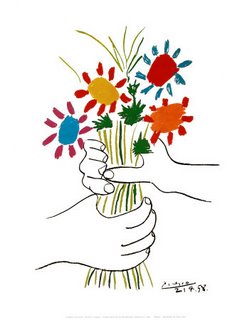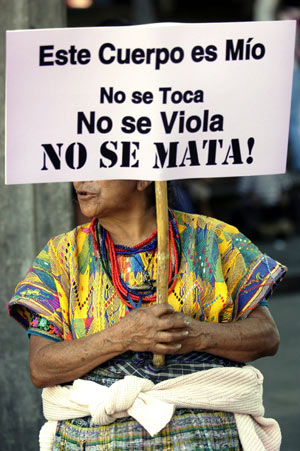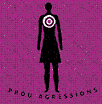BIBLIOGRAFÍA y RECURSOS ELECTRÓNICOS
Red de Centros de Documentacion y Bibliotecas de Mujeres
La Red de Centros de Documentación y Bibliotecas de Mujeres, se crea en 1994 para promocionar y difundir la labor de los centros integrantes, ubicados en territorio español. Esta Red no depende de ningún organismo administrativo.
Integrantes de la Red:
- Centros dependientes de organismos públicos.
- Centros especializados de Universidades
- Bibliotecas de mujeres creadas por asociaciones vinculadas al movimiento feminista.
Características de los Centros pertenecientes a la Red:
- Están especializados en documentación sobre mujeres, son de uso público y cuentan con personal especializado.
Centros de Documentación y Bibliotecas que integran la Red:
http://www.emakumeak.org/cdoc/RED/
OTROS CENTROS DE INTERES
NAZIONALE DELLE DONNE
Biblioteca que recoge la produccin italiana sobre mujer y género
DOCUMENTATION CENTRE AMAZONE
Contiene documentación sobre igualdad de oportunidades en Bélgica
http://www.amazone.be
DUODA.Centre de Recerca de Dones
Centro de investigacin de mujeres, dependiente de la Universidad de Barcelona
http://www.ub.es/duoda
FAWCETT LIBRARY
Fondo centrado en Gran Bretaa, la Commonwealth y el Tercer Mundo
http://www.thewomenslibrary.ac.uk
IFLA
(International Federation of Library Associations and Institutions)
Contiene informacin sobre bibliotecas de mujeres http://www.ifla.org/VII/s41/swi.htm
IIAV
(International Information Centre and Archives for the Womens Movement)
Centro de Información y archivo del movimiento feminista holands. http://www.iiav.nl
INSTITUTO ARAGONES DE LA MUJER. CENTRO DE DOCUMENTACIÓN
http://portal.aragob.es/pls/portal30/url/folder/iam
SCHLESINGER LIBRARY
Biblioteca sobre la historia social de las mujeres en los Estados Unidos.
http://www.radcliffe.edu/schles
SOSIG
(Social Science Information Gateway Womens Studies)
Documentacin sobre Ciencias Sociales, en general, y estudios sobre la mujer. http://sosig.esrc.bris.ac.uk/womens_studies
THE DANISH CENTRE FOR INFORMATION ON WOMEN AND GENDER
Biblioteca danesa con información sobre la mujer y los estudios de género http://www.kvinfo.dk
THE WOMENS LIBRARY
Biblioteca nacional sobre la historia de las mujeres en el Reino Unido http://www.thewomenslibrary.ac.uk/read_home.htm
UNIVERSITY OF MARYLAND. Womens Studies Database
http://www.inform.umd.edu/edres/topic/womensstudies
WSSLINKS:
Women and Gender Studies Web Sites
Recopilación de sitios de Estudios sobre la Mujer
http://www.libr.org/wss/wsslinks
ORGAND:
Observatoire sur le developpement regional et l'analyse differencie selon les sexes http://www.oregand.ca
Bibliografía sobre estos temas que te puede interesar
Abramson, L. Seligman, M. & Teasdale, . (1978) Learned helplessness in humans: critique and reformulation. Journal of abnormal psychology.
Abramson, L., Alloy, L. & Metalsky, G. (1995) Hopelessness depression. En G Buchanan y M Seligman (eds) Explanatory style. Hillsdale, NJ: Eribaum
Amnistía Internacional (2002) No hay excusa: violencia de género en el ámbito familiar y protección de los Derechos Humanos de las mujeres en España. Nov., 343, 6.
Amor, P.J., Echeburúa, E., de Corral, P., Zubizarreta, M., Sarasua,B. (2002) Repercusiones psicopatológicas de la violencia doméstica en la mujer en función de las circunstancias del maltrato. Revista Internacional de Psicología Clínica y de la Salud. International Journal of Clinical and Health Psychology, Vol. 2, Nº 2, pp.227-246
Bonino, L. (1998) Micromachismos, la violencia invisible. Madrid, Cecom
Bonnano, G. (2004) Loss, Trauma and human resilience. American Psychologist. Vl.59, Nº1, 20-28. Jan.
Caprara V. & Cervone, D. (2003) A conception of personality for a psychology of human strengths: personality as a agentic, sefl regulating system. In A Psychology of Human Strenghts. Positive Psychology. Aspinwall, L (Ed)
Chronister, K. & McWhirter, E. (1996) Practice, 2, 63-80. Applying Social Cognitive Career Theory to the Empowerment of Battered Women , Journal of Counseling & Development, 0748-9633 begin_of_the_skype_highlighting 0748-9633 end_of_the_skype_highlighting, September 1, 2003, Vol. 81, Issue 4
Corsi, J. (1994) Violencia familiar. Buenos Aires, Paidós
Dobash, R. & Dobash R.P. (1992) The therapeutic society constructs battered women and violent men. In Dobash and Dobash (Eds.) Women, violence and social change. London. Routledge.
Dutton M.A. (1992) Empowering and healing the battered woman: a Model of assessment and intervention. N York, Springer Publishing Co Dutton, M.A. (1993) Understanding women’s responses to domestic violence: A redefinition of battered women syndrome. Hofstra Law Review, 21(4), 1191-1242.
Dutton, D. G. & Painter, S. (1996) The battered woman syndrome: effects of severity and intermittency of abuse, American Journal of Psychiatry, vol. 63, No. 4, pp. 614-622.
Etcheburua, E., de corral P. y Amor, P. (2003) Evaluation of psychological harm in victims of violent crime. Colegio Oficial de Psicólogos. Copyright by the Psychology in Spain, 2003, Vol. 7. No 1, 10-18
Fredrickson, B.L. (2000) The role of positive emotions to optimize health and well-being. The broaden-and-built theory of positive emotions. American Psychologists, 56, 218-226.
Freire, P. (1971) Pedagogía del oprimido. Tierra Nueva. Buenos Aires Sigo XXI.
Freyd, J.J (1999) Blind to Betrayal: New Perspectives on Memory for Trauma. The Harvard Mental Health Letter, 15 (12) 4-6.
Garrido, V. (2001) Amores que matan. Acoso y violencia contra las mujeres. Ed. Algar, Valencia.
Gondolf, E. W., & Fisher, E. R. (1988) Battered Women as Survivors: An alternative to treating learned helplessness. Massachusetts/Toronto: Lexington Books.
Gracia Fuster, J. (2002) Las víctimas invisibles de la violencia familiar. Paidós, Barcelona.
Hardin, A & Sukola, K. (1998) Empowering abused women: multicultural counseling techniques. Relating in a global community ”Proceedings of the international Conference on counseling in the 21 st century, Sidney, Australia, Dec 31.
Herman, J. L. (1992) Trauma and Recovery. USA: Basic Books.
Innocenti Digest (2000) Innocenti Research Centre. Vol 6.( June) Unicef Florence, Italy
Instituto de la Mujer (2000) Macroencuesta. Ministerio de Trabajo. España.
Instituto de la Mujer (2002) Mujer, Violencia y Medios de Comunicación. Dossier de Prensa Instituto Oficial de Radio y Televisión. RTVE, 2002. Ministerio de Trabajo y Asuntos Sociales
Johnson, J. &. Wiechelt S.(2004) Introduction to the Special Issue on Resilience. Substance Use and Misuse Vol. 39, No. 5, pp. 657–670, 2004
Labrador, F. et al (2004) Mujeres víctimas de violencia doméstica. Ed. Pirámide, Madrid.
Laing L. Australian Domestic & Family Violence (2000) CLEARINGHOUSE Working with women: Exploring individual and group work approaches.
Lempert L.B. (1996) Women strategies for survival: Developing agency in abusive relationships. Journal of Family violence, vol 11
Linley, P. & Joseph, S. (2005) The Human Capacity for Growth Through Adversity. American Psychologist, Vol 60(3), Apr. pp. 262-264. American Psychological Assn
Lorente, M. (2001) Mi marido me pega lo normal. Ares y Mares. Barcelona
Maddux, J. (2002) Self-efficacy: the power of believing you can. In Handbook of positive psychology. Oxford University Press.
Maier, S. & Seligman, M. (1976) Learned helplessness: theory and evidence. Journal of Experimental Psychology: General 105.
Masten, A. (2001) Ordinary Magic: resilience processes in development. In A Psychology of Human strengths. Fundamental Questions and Future Directions for a Positive Psychology. Ed. Spinwall, L & Staudinger, U. American Psychological Association, Washington.DC
Masten, A. S. & Reed, M.G. (2002) Resilience in development. In: Snyder, C. R., Lopez, S. J., eds. The Handbook of Positive Psychology. Oxford University Press, pp. 74–88.
McWhirter, E. H. (1997) Empowerment, social activism, and counseling. Counseling and Human Development, 28, 1-14.
Michigan Judicial Institute (2001) Mitigating the psychological effects of victimization.
Olson, L, Fine, M & Lloyd, S. (2004) A Dialectical Approach to Theorizing About Aggression Between Intimates. Definitions of Aggression, Battering, Abuse, and Violence.
Organisation Mondiale de la Santé (1997) La violence à l'égard des femmes Santé de la famille et Santé reproductive Un problème de santé prioritaire,Geneve, Suisse.
Paradine, K. (2000) The Importance of Understanding Love and Other Feelings in Survivors’ Experiences of Domestic Violence. Court Review - Spring 2000
Resick, P. (1987) Psychological effects of victimization: Implications for the criminal justice system,Crime & Delinquency 33, 468, 477.
Sanmartín, J. (coord.) (2004) El laberinto de la violencia. Centro Reina Sofía para el estudio de la violencia. Edit. Ariel, Barcelona.
Sarasúa, B y Zubizarreta. (2000) Violencia en la pareja. Ed. Aljibe. Málaga.
Satir, V. (1995) Autoestima, Ed Fax, México.
Seligman, M & Nolen-Hoeksema, S. (1987) Explanatory style and depression. In D. Magnusson and A. Ohman, (Eds.) Psychopathology: An Interactional Perspective. New York: Academic Press, 125-139.
Seligman, M. & Csikszentmihalyl, M. (2000) Positive psychology. American Psychologist, Jan 2000, vol 55, Nº 1, 5-14.
Seligman, M. (1991) Learned optimism. How to change your mind and your life. NYork. Knopf.
Seligman, M. (2002) Positive psychology, positive prevention, and positive therapy. In Handbook of positive Psychology. Oxford Univ. Press.
Seligman, M. (2003) La auténtica felicidad. Ed Vergara, Barcelona.
Stark, E. & Flitcraft, A. (1996) Personal Power and Institutional Victimization. In E. Stark & A. Flitcraft (Eds.), Women at Risk: Domestic violence and women’s health (pp. 157-191) Thousand Oaks: Sage.
Tugade, M,, Fredrickson, B. & Barrett, L. (2004) Psychological resilience and positive emotional granularity: Examining the benefits of positive emotions on coping and health. Journal of Personality, Vol 72(6)(Dec). Special issue: Emotions, Personality, and Health. pp. 1161-1190.
Van der Kolk B. & Saporta J. (1991) The biological response to psychic trauma: mechanisms and treatment of intrusion and numbing. Anxiety Research UK,4:199-212.
Van der Kolk, B. (1996)Traumatic Stress: the effects of overwhelming experience on mind, body, and society. Guilford Press.
Villavicencio, P. (2000) Violencia doméstica: Estrategias. En Las mujeres en el año 2000: hechos y aspiraciones. Seminario organizado por el Instituto de la Mujer, 11 y 12 de mayo de 2000. Ponencias y Conclusiones (pp77-88) Madrid, Instituto de la Mujer.
Walker, L. (1984) The Battered Woman Syndrome, Springer Publishing Company, New York.
Walker, L. (1994) Abused women and survivor therapy: A practical guide for the Psychotherapist. Washington, DC: APA Press.
Werner, E. & Smith, R. (2001) Journeys from Childhood to Midlife: Risk, Resilience, and Recovery. Ithaca, NY: Cornell University Press.
Palabras de una gran Mujer
"El día en que sea posible que la mujer ame, no con su debilidad sino con su fuerza, no para escapar de si misma sino para encontrarse, no para rebajarse sino para reafirmarse; aquel día el amor llegará a ser para ella, como para el hombre, una fuente de vida y no de peligro mortal".
(Simone de Beauvoir, 1949)
Dicho por Saramago
"La violencia ejercida desde siempre sobre la mujer encuentra en la cárcel en que se transforma el lugar de cohabitación (neguémonos a llamarle hogar), el espacio por excelencia para la humillación diaria, para la paliza habitual, para la crueldad como método. Es el problema de las mujeres, se decía, y eso no es verdad. El problema es de los hombres, del egoísmo de los hombres, del enfermizo sentimiento posesivo de los hombres, de la bajeza de los hombres, de esa miserable cobardía que los autoriza a usar la fuerza bruta contra un ser más débil físicamente y al que antes se le ha reducido la capacidad de resistencia moral." José Saramago, Diario El País, 25.11.03. www.hombresigualdad.com/cobardia_hombres_Saramago.htm
* VIDEOS *
Ver You Tube
Videos contra la violencia sexista y a favor de la igualdad
El final del cuento de hadas
Suscribirse a:
Entradas (Atom)
MEJOR UN HOMBRE CUIDADOR QUE UN HOMBRE "DE CUIDADO"
MUJERES HUMANAS, MUJERES DIVINAS
NO TOMES LO HABITUAL COMO NATURAL, PIDE AYUDA
NO A LA CUSTODIA COMPARTIDA IMPUESTA POR VIA JUDICIAL
EN LA VIOLENCIA SEXISTA LOS NIÑOS TAMBIÉN SON VÍCTIMAS
NO A LA VIOLENCIA CONTRA LOS NIÑOS Y NIÑAS
REPITO: NO A LA VIOLENCIA CONTRA LOS NIÑOS Y NIÑAS
"Contra la Injusticia": NO A LA VIOLENCIA INFANTIL...¡¡¡¡¡: " UN NIÑO LE DIJO A SU MADRE: MAMI HE PINTADO TUS SABANAS BLANCAS CON TU LÁPIZ DE LABIOS.LA MADRE ENFADADA GOLPEO ..."
IGUALDAD PARA LAS INVISIBLES
INVISIBLES - Igualdad de Género from ATTAC.TV on Vimeo.
HAY QUE CAMBIAR ESTO: Campaña POR SER NIÑAS
OPORTUNIDADES PARA LAS NIÑAS!
LAS AMIGAS CURAN
ME DECLARO VIVA

La imagen del Fénix
El Ave Fénix es un ave mitológica que volvía a renacer de sus propias cenizas; ha sido un símbolo del renacimiento físico y espiritual. Poseía varios dones, como la virtud de que sus lágrimas fueran curativas.
http://4.bp.blogspot.com










































